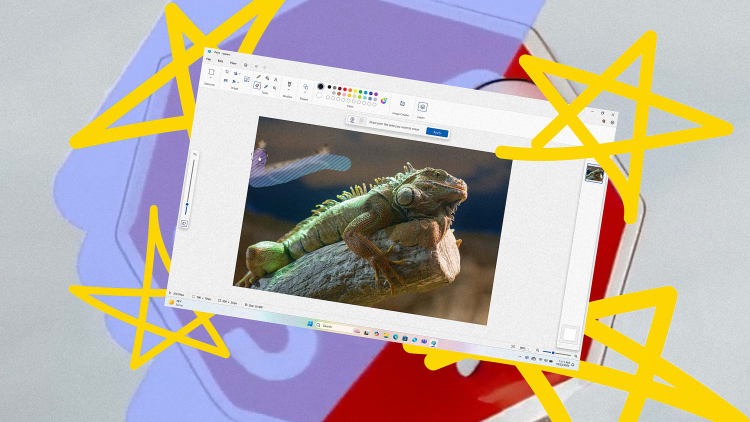- | 8:00 am
Microsoft Paint, once a joke, could be the future of image editing
MS paint now lets you use powerful AI features like Generative Fill and Erase—for free.

Once upon a clock.exe, Microsoft Paint was just a sad copy of the iconic MacPaint that shipped with every Macintosh back in 1984. Released in 1985 as part of Windows 1.0, Paint (barely) evolved with its operating system, turning from clone to hated app to beloved source of endless memes, almost ending in the Recycling Bin along with Clippy.
During this journey, Paint became an icon in its own right, which is maybe the reason why the Redmond, Washington, company chose to remake the software into a powerful (and free) AI-powered image editor available on Windows 11 and CoPilot+ PC, the new computer designed to compete head-to-head against the mean and lean Apple Silicon machines.
Microsoft’s latest Paint update introduces key generative AI tools like Generative Fill and Generative Erase. They are key because, let’s face it, it’s what most of us mortals need when it comes to image editing. That and the now ever-present magic wand to prettify images.
The new MS Paint AI tools are designed to allow users to easily modify images by simply selecting areas to alter. Don’t like the background? Change it with a click and a few words. Want to fix your brother-in-law’s annoying photobomb? Click and boom! Gone. There’s no need to carefully select, mask, feather, clone, and endlessly tweak an image to make it all work. It just does the job, according to the company.
“With the addition of generative fill and generative erase, you can edit and alter images with greater precision and creative freedom,” Microsoft says in its official statement. Microsoft unveiled a handful of new AI features for its updated operating systems, which also include a resolution upscaler designed to increase images to 8 times their original size and enhance your old, low-resolution and photos “into high-quality images without worrying they’ll look blurry or pixelated […].”
All these AI features run on the cloud at no charge for users. Paint is designed to add or remove objects, change backgrounds, and even make fine adjustments, all without the learning curve associated with more advanced software like Photoshop, for free in basically every computer out there. What used to take hours of complex editing now happens in seconds, and Microsoft Paint, once thought to be an obsolete toy, is destined to become a truly useful tool for users worldwide.

The elephant in the room
Paint is only the latest soldier to join the army of free AI-powered tools coming from Meta, Google, and even phone companies like Samsung or Xiaomi. An army that also has consumer and prosumer giants like Canva in its ranks. They’re all coming slashing and crushing to democratize image editing for everyone. That’s very bad news for Adobe.
For decades, Adobe Photoshop has dominated image editing in the professional and prosumer space. For a long time, the company was limited to those markets because its tools were too complex for casual users. So Adobe moved aggressively to change its UX and try to get into the consumer space with new apps like Adobe Express, while also embracing a subscription model.
It was a successful move for Adobe, but the arrival of these new, free AI tools (backed by huge corporations that reach a massive user base) opens a critical question: Why would the average user need Photoshop when they can instantly and seamlessly manipulate images with free tools on their phones or PCs?
The new era of image editing tools
Take Meta, which is advancing in this space by introducing its AI-powered photo editing tools during the September 2024 Meta Connect event. Meta AI is even going beyond MS Paint. Its multimodal AI—which has a grasp of the world at the visual and textual level—can now understand what is in the image and manipulate them without any effort whatsoever.
A “change those sneakers to ballet shoes, and turn that T-shirt into a fluffy pirate shirt” prompt will work because the AI knows what you are talking about. “Meta AI is on track to being the most used AI assistant in the world by the end of this year. . . . We’re almost at 500 million monthly active [users],” Mark Zuckerberg said during the presentation event last week. Meta AI allows users to change outfits, remove objects from images, and even generate new backgrounds directly within apps like WhatsApp, Instagram, and Messenger, at no extra cost.
Similarly, Google’s Magic Editor offers people the ability to move, resize, and remove objects in images with just a few clicks. Take a photo with an unwanted background element? Google’s AI lets users erase it instantly. It gives amateur users professional-grade, easy to use editing tools.
Meanwhile, Canva has been chipping away at Adobe’s dominance. The company has been adding AI features to its suite of products, like Magic Edit, powered by Stable Diffusion, which allows users to transform images with text prompts. As with Paint, if you want to remove an object from a photo or change the background entirely, Canva’s AI-based editor lets users do that with a single click. Canva also introduced Magic Grab, a tool that isolates individual elements within a photo, making them easy to resize or reposition.
Like Paint, these platforms share one critical advantage over Adobe: accessibility. Aside from Canva, they are either free to download or bundled with existing devices, giving consumers and prosumers advanced editing capabilities without needing to invest in costly software subscriptions.
For years, Photoshop held a monopoly over image editing thanks to Adobe’s core audience of professional photographers and artists. Now, some of those artists are growing disillusioned with the company’s AI pivot. In a May 2024 open letter to Adobe, the American Society of Media Photographers expressed outrage over a recent Photoshop marketing campaign that encouraged users to “skip the photoshoot.” At the same time, Adobe’s AI-powered tools have left some professional users feeling sidelined.
This disconnect between Adobe and the professional community comes at a critical time when free, powerful tools are rising in quality and popularity. And now, with Microsoft Paint entering the race, we might finally be entering a new era of democratized image editing.







































